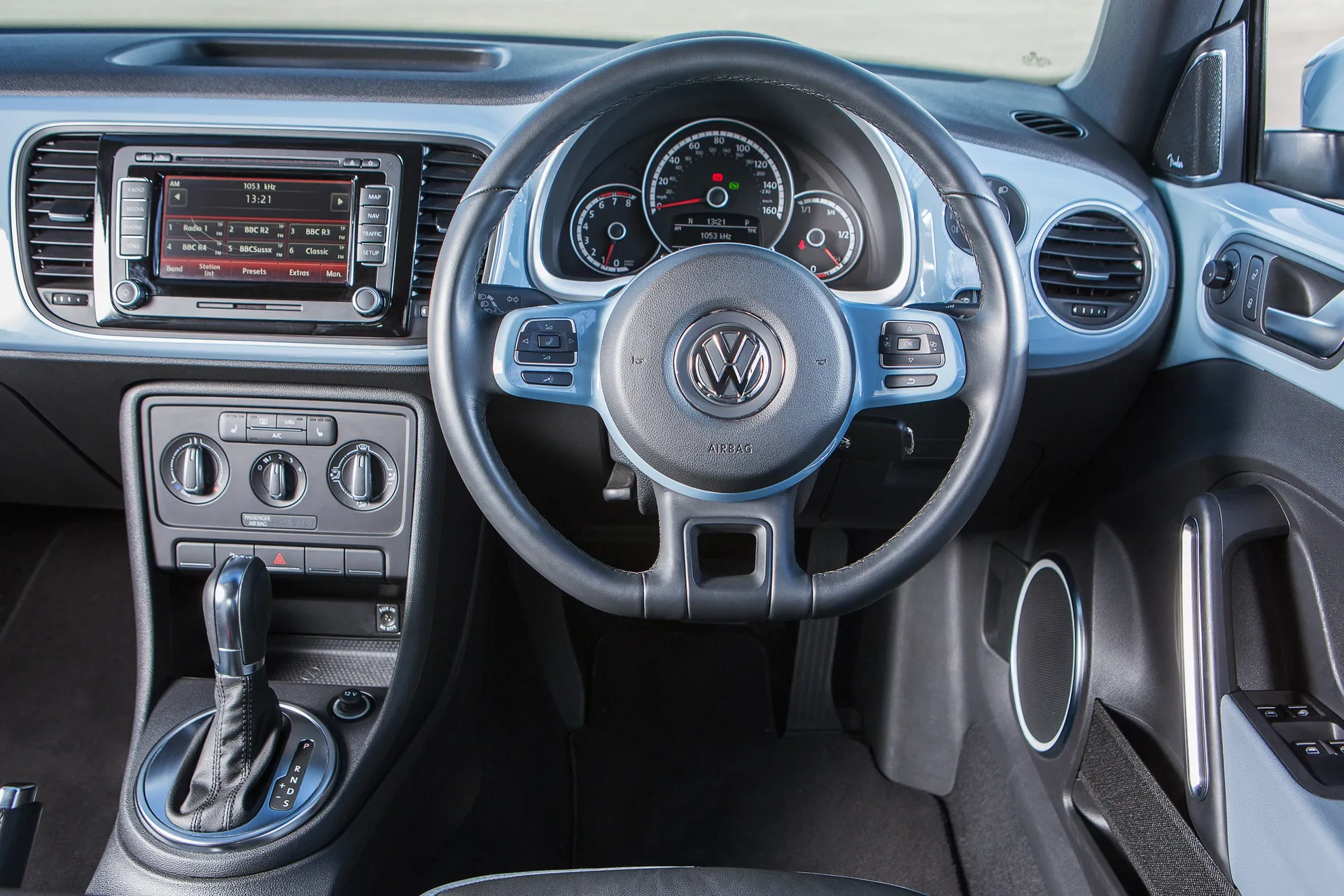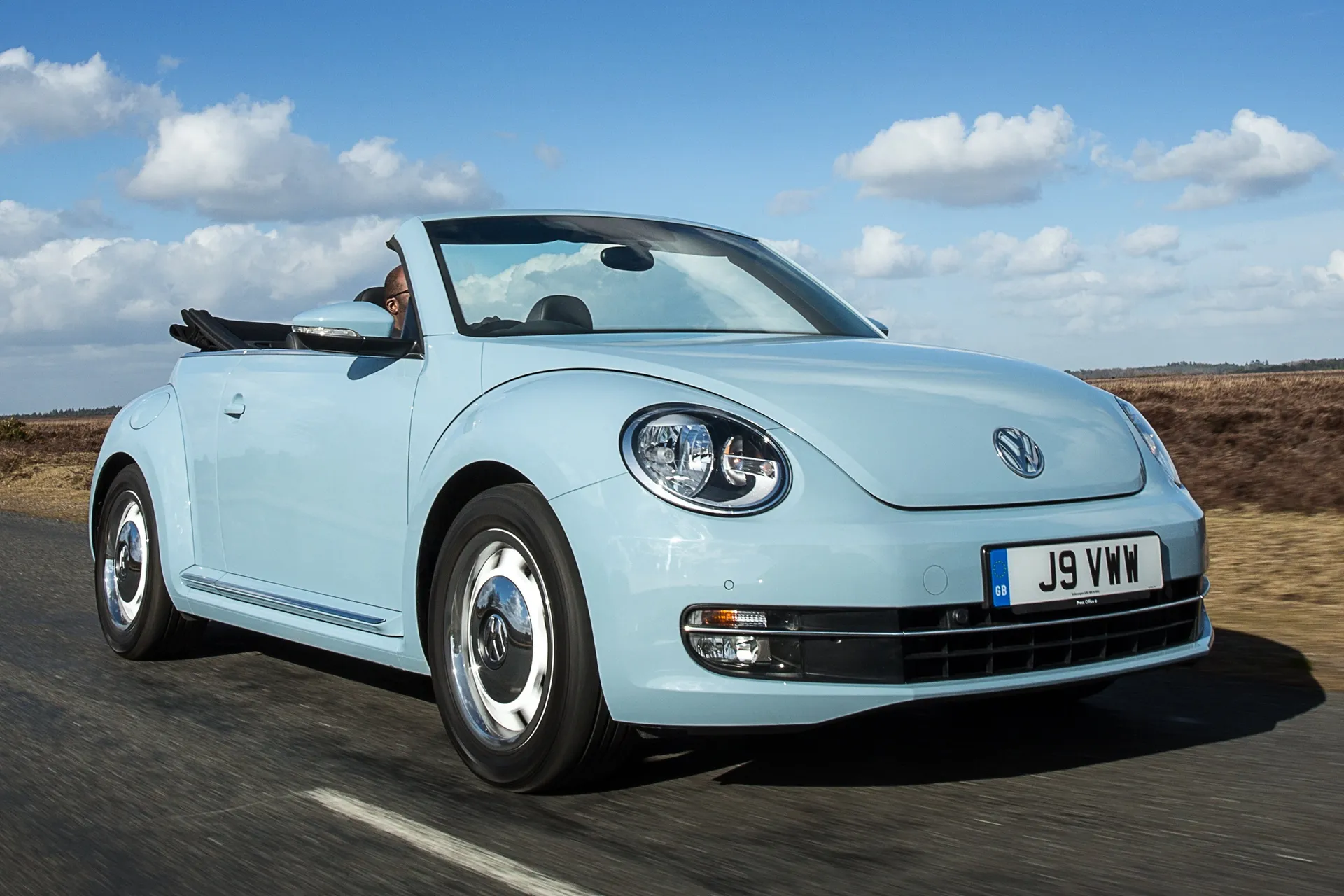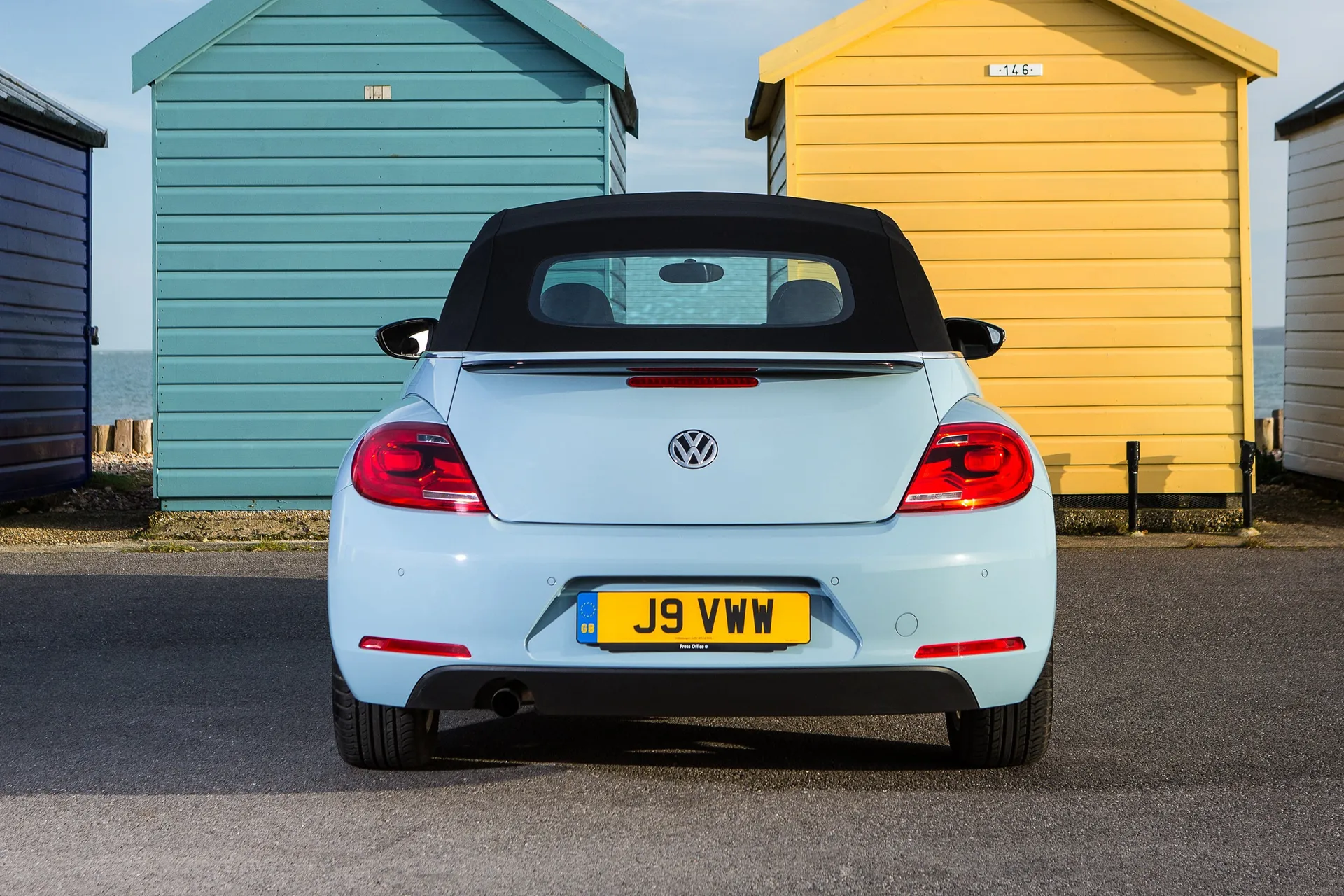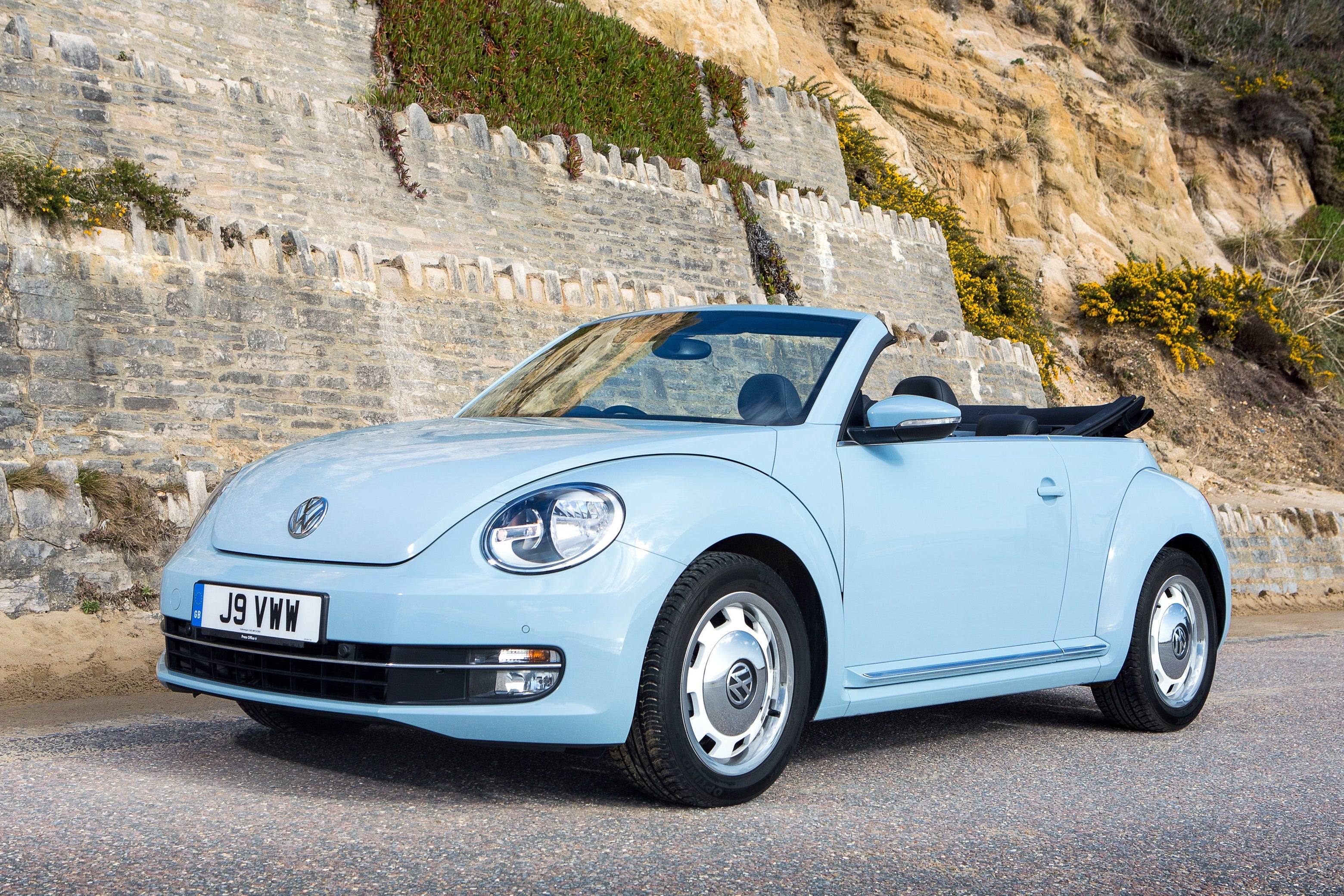Volkswagen Beetle Cabriolet Review
Written by Andrew Brady
Quick overview
Pros
- Retro styling sets it apart from the mass market
- Fun ownership experience
- Relatively practical for a convertible
Cons
- Rather expensive for what it is
- A Volkswagen Golf is cheaper and more practical
- Ride quality suffers on large wheels
Overall verdict on the Volkswagen Beetle Cabriolet
"Thanks to its divisive styling, high price tag and limited practicality, the Volkswagen Beetle Cabriolet is never going to be anything other than a niche purchase. If you like the looks and the idea of a topless Beetle, there’s plenty to love here."

Cars like the Volkswagen Beetle Cabriolet are a dying breed. Take a look at the Volkswagen range in 2020 and you’ll see just one convertible. It’s the T-Roc Cabriolet and it’s based on a compact crossover.
The fact is, not enough of you bought the Beetle Cabriolet, which is why production ceased in 2019. But the fact that you’re here suggests you might be interested in the topless Beetle, so why should you choose it over the Beetle coupe?
Practicality isn’t going to be high on your list of priorities in either car, so you can probably put up with the fact that the Cabriolet offers a smaller boot. More positive is the fact that there’s enough room in the cabin for four adults, even with the roof up. It’s not cavernous, but it’s far more spacious than the MINI Convertible.
The styling is divisive, but the low stance and wide haunches give the Beetle Cabriolet a unique and modern look, without being overly retro. Although it’s a little short on personalisation options, there are enough colours and wheel choices for you to stamp your mark on the car.
Inside, the cabin isn’t as bold or individual as the outside, but the quality is on par with other Volkswagen models. Although the entry-level version is well-equipped, we’d recommend the mid-range Design trim for the fact that the dashboard, door cards and steering wheel are finished in the same colour as the exterior.
We also like the circular air vents and the storage compartment in the dashboard, which is a subtle but effective nod to the original Beetle. The Sport and R-Line trims give the Beetle a sporting character it can’t live up to, while the Dune features raised suspension to deliver a softer ride.
Speaking of which, you’ll want to avoid the 19- and 20-inch alloy wheels, as these serve to ruin the otherwise good ride quality. It’s not cushion-soft, but the suspension is nicely set-up for boulevard cruising and high-street posing.
There’s a broad choice of engines to choose from, ranging from efficient and punchy diesel engines to a seriously quick 220PS 2.0-litre TSI petrol. We’d recommend the 1.4-litre TSI petrol if you spend time in and out of the city, or the impressive 1.2-litre TSI petrol if most of your time is spent in town.
What are the drawbacks? Well, practicality is never going to be a Beetle Cabriolet's strong point and there’s the not-so-small matter of the high prices when the car was new. Although we can’t do anything about the amount of space, we can tell you that the Beetle Cabriolet is more affordable to buy used.
It’s not as fun to drive as the MINI Convertible, but it feels slightly more upmarket and offers more space. You’ll also enjoy a tad more exclusivity if you opt for the Volkswagen.
If you're looking for the hard top version, you need our Volkswagen Beetle review.
Is the Volkswagen Beetle Cabriolet right for you?
The Volkswagen Beetle Cabriolet is the kind of car you’ll be prepared to make a few sacrifices for. Why buy a Golf when you can own something with a huge dollop of retro cool, a degree of exclusivity and the opportunity for some wind-in-your-hair motoring?
It’s not as though the sacrifices will cause you too many headaches. The boot is reasonably large, there’s room for two adults in the back, and the running costs will be on a par with the less distinctive cars in the Volkswagen range.
One of the Beetle Cabriolet’s biggest problems was its high price, but this is less of an issue on the used car market. In fact, sales slowed to such an extent, your biggest challenge will be finding the right car for you. Is the Cabriolet worth the premium over the Beetle coupe? Come back to us with an answer the next time the sun is shining.
What’s the best Volkswagen Beetle Cabriolet model/engine to choose?
Although the TDI diesels offer the best economy, do you really want to hear the sound of a diesel engine when you lower the roof? It kind of sends a torpedo through those cool ‘West Coast’ vibes, dude.
Which is why we recommend one of the petrol engines. The 1.4-litre TSI is the one to opt for if you spend as much time on the open road as you do searching for a parking space in a beach car park. It offers a fantastic blend of immediate urgency and long-legged cruising ability. Having said that, the 1.2-litre TSI will be perfectly adequate for most people.
We’re not going to suggest a trim level, because it’s a matter of taste. The key is to find a used example that is right for you. We do have a soft spot for the 50s Edition, 60s Edition and 70s Edition models that were available at launch, mind.
What other cars are similar to the Volkswagen Beetle Cabriolet?
The MINI Convertible is the most obvious rival, as it sacrifices practicality for some wind-in-your-hair fun. Like the Beetle Cabriolet, it’s more expensive and less practical than the tin-top equivalent, but it offers desirability by the bucket-and-spade load.
Beyond that, it’s difficult to find a direct rival. The Fiat 500C and DS 3 Cabrio are little more than cars with a long sunroof, so you’re looking at more expensive alternatives like the Audi A3 Cabriolet, Audi TT Roadster, BMW 2 Series Convertible and Mercedes-Benz C-Class Cabriolet.
Comfort and design: Volkswagen Beetle Cabriolet interior
"In standard form, the interior of the Volkswagen Beetle Cabriolet is nowhere near as bold as the exterior styling. It’s all a bit grey and predictable, although the three-spoke steering wheel, stacked circular instruments and round air vents are neat touches."

Upgrading to Design trim is worth it, if only for the door panels, upper dashboard and steering wheel inserts that are matched to the exterior colour. There are also chrome details for the door speaker surrounds, air vents, door handles and gear lever gaiter.
By far our favourite touch is the storage compartment in the dashboard directly above the glove box. It’s a subtle but evocative nod to the original Volkswagen Beetle. Little details matter.
Some models also get a three-dial ‘Sport’ instrument panel on the top of the dashboard. The dials show oil temperature and turbocharger boost, as well as a stopwatch that measures journey time.
The driving position is spot on, with height-adjustable seats as standard across the range. The fabric seats on the entry- and mid-range versions are comfortable, but sport seats on the higher trim levels provide more support.
Manual air conditioning comes as standard, but the dual-zone climate control provides more flexibility, especially if you’re running the Beetle Cabriolet through the winter. Speaking of which, a winter pack is a must-have upgrade, as it features heated front seats and heated windscreen washer jets.
Overall, the Beetle Cabriolet boasts a comfortable cabin for all four occupants. That’s more than you can say for the MINI Convertible.
Quality and finish
Interior quality is generally good, but some of the plastics feel a little cheap. This is especially true of the entry-level version, which misses out on the cosmetic enhancements that help lift an otherwise sombre cabin.
On the plus side, the dials turn and the switches press with the usual Volkswagen reassurance, but the Beetle Cabriolet doesn’t feel like a premium product until you hit the upper reaches of the trim ladder.
Thanks to the cosmetic upgrades, Design trim offers an enhanced feeling of quality, while models with a leather-trimmed steering wheel and gear lever feel a touch more special.
A word about the electric folding roof, which opens in 9.5 seconds and can be operated at speeds of up to 31mph. It’s a quality piece of kit, with the multi-layered fabric roof and safety glass delivering a feeling of quality when the roof is in place.
Unfortunately, leather seats are optional, regardless of the trim level, but this isn’t the only way to make the cabin feel more upmarket. The Dune model manages to feel premium without leather, thanks to ‘Turmeric’ cloth seats with contrast stitching, a multi-function leather steering wheel and dual-zone climate control.
Infotainment: Touchscreen, USB, sat nav and stereo in the Volkswagen Beetle Cabriolet
The entry-level Beetle Cabriolet comes with a five-inch colour touchscreen with an aux-in socket, DAB digital radio, a dash-mounted CD player, SD card reader, USB port and six speakers. It’s a basic system, but it’s easy to operate on the move thanks to a set of large buttons flanking the screen.
Other models get an improved and larger 6.5-inch colour touchscreen with DAB digital radio, CD player, eight speakers, text messaging function and Bluetooth. The fact that satellite navigation isn’t available as standard on any of the trim levels is a little stingy.
Thus, the Discover Navigation system is a good upgrade and worth sourcing when you’re looking at used examples of the Beetle Cabriolet. It comes with European mapping, speed limit information and three calculated route choices.
Another desirable option is the Fender premium audio upgrade, which comprises a 400-watt output from the eight speakers and Panasonic/Fender upgrade. You also get ambient illumination around the speakers, door panels and under the door trim. The Beach Boys have never sounded – or looked – better, man.
Space and practicality: Volkswagen Beetle Cabriolet boot space
You wouldn’t expect the Volkswagen Beetle Cabriolet to offer the same level of practicality as the Golf, so you’re unlikely to be disappointed by the space on offer here. It’s more spacious than the previous Beetle Cabriolet and more commodious than the MINI Convertible.
The boot offers 225 litres of boot space, which is significantly less than the 310 litres you get in the Beetle coupe. Crucially, because the roof folds away on the outside of the car, the luggage capacity is the same whether the roof is up or down.
Inside the boot, you’ll find a lever to fold the rear seats down. It’s not going to rival a hatchback for practicality, but it might help if you need to carry some longer loads. With the seats up the boot is big enough for a large suitcase, once you’ve ‘posted’ it through the relatively narrow opening.
In the cabin, the Beetle Cabriolet feels more spacious than its predecessor, regardless of whether the roof is up or down. Volkswagen shifted the windscreen rearward, which altered the contours of the roof, creating 12mm more rear headroom in the process. It doesn’t sound like a lot, but it means that two adults can sit in the back without feeling like they’re in the cheap seats. Legroom is adequate, which gives the Beetle the edge over the MINI.
Getting in the back is made easy by the sliding front seats, which return to their previous position once your passengers have clambered in.
There are two cup holders between the front seats, a large glove box, a retro storage compartment in the dashboard, large door bins and a compartment at the base of the centre console. There’s also a centre armrest with a shallow storage compartment that’s perfect for carrying a smartphone.
Versions without the sports dials atop the dashboard also get a shallow tray on the dash. All models get a tonneau cover to keep the roof stored away when lowered.
Handling and ride quality: What is the Volkswagen Beetle Cabriolet like to drive?
"There’s no doubt that the Volkswagen Beetle Cabriolet feels more at home on a boulevard than it does on a twisty country lane, but it’s far nicer to drive than the old model. That said, the MINI Convertible remains the default choice for pure driving pleasure."

The ride is a little on the firm side, but you can mitigate the effects of this by avoiding the larger wheels. The 19- and 20-inch alloys might look the part, but your spine will thank you for choosing one of the 17-inch or 18-inch versions. Don’t worry, you don’t have to go as far as the 16-inch steel wheels – you’re entitled to a little glamour.
We’d also avoid the R-Line trim, introduced in 2016. Although it looks the part, with its body-coloured rear diffuser, chromed twin exhausts and rear spoiler, the sports suspension writes cheques it cannot cash.
If anything, we’d opt for the Beetle Dune, also introduced in 2016. It was comically expensive when new, but the 10mm increase in ride height helps to cushion you from the imperfections in the road, creating a more supple ride quality.
Overall, the Beetle Convertible feels roughly the same to drive as the Beetle coupe, thanks in no small part to some extra bracing. This is high praise, because removing the roof from a car designed as a tin-top can lead to a rather flexible and wobbly driving experience. It helps that the Beetle is based on a platform shared with the Golf.
The roof lowers in 9.5 seconds at speeds of up to 31mph. Should you get caught in a rain shower, you’ll be pleased to know that it closes in 11 seconds, so you won’t be left looking like a drowned rat. You don’t want to spoil that expensive haircut.
What engines and gearboxes are available in the Volkswagen Beetle Cabriolet?
There are a number of engines available, ranging from efficient diesels to a seriously punchy 220PS petrol motor. We’d avoid the diesels, though. Although they offer excellent economy, we don’t think they suit the character of the Beetle Cabriolet.
The 220PS 2.0-litre TSI petrol engine is a firecracker of a motor, capable of propelling the Beetle Cabriolet to a top speed of 143mph, hitting 62mph in just 6.9 seconds. It’s expensive to run, but it’s a whole lot of fun.
We’re also big fans of the 150PS 1.4-litre TSI engine, which combines a supercharger and a turbocharger to deliver a 0-62mph time of 9.1 seconds. However, the 105PS 1.2-litre TSI is arguably all the petrol engine you need. The 0-62mph time is a leisurely 11.7 seconds, but it suits the relaxed nature of the Beetle Cabriolet.
Although a 1.6-litre TDI engine was available at launch, we’d recommend the 2.0-litre TDI for its blend of performance and efficiency. There are two versions: 105PS and 150PS, with the latter hitting 62mph in a respectable 9.3 seconds. The additional torque and mid-range punch gives it the edge over the petrol engines.
The six-speed manual gearbox is perfectly fine, but we’d opt for the seven-speed DSG automatic transmission for its laid-back and relaxed approach. It doesn’t like being hurried, but we don’t think that will be a problem for the majority of Beetle Cabriolet owners. Chill out.
Refinement and noise levels
The Volkswagen Beetle Cabriolet feels remarkably refined, regardless of whether the roof is open or closed. There’s very little wind noise until you hit motorway speeds, but this helps to drown out the road noise. You have to expect some degree of noise in a convertible, but the Beetle Cabriolet does a great job of keeping unwanted sounds to a minimum.
If you’re not carrying any rear passengers, we’d suggest fitting the wind deflector, which makes things feel very pleasant in the front. Without it, you’ll notice a little wind on the top of your head, so hold on to your hat. The insulated roof maintains the same level of refinement you’d find in the Beetle coupe, plus you get the added benefit of lowering the front and rear windows to create a different experience. It’s like driving a coupe with frameless windows.
For maximum refinement we’d recommend the DSG transmission. The seamless shifts and relaxed nature create a more upmarket feel, even if the transmission can be a little hesitant at low speeds. The diesel engines can be noisy at idle and when pushed hard, but the 1.2- and 1.4-litre petrol engines are quiet around town.
Safety equipment: How safe is the Volkswagen Beetle Cabriolet?
The Beetle Cabriolet wasn’t crash-tested by Euro NCAP, but the Beetle coupe was awarded a five-star rating in 2011. It achieved an impressive set of results, scoring 92% for adult occupant protection, 90% for child occupant protection, 53% for pedestrian safety and 86% for safety assist systems.
All versions of the Beetle Cabriolet are fitted with electronic stability control, a rollover protection system, two Isofix child car seat mounting points in the rear, a tyre pressure monitor and a suite of airbags. There’s also a post-collision braking system, which applies the brakes for as long as possible to minimise the severity of subsequent collisions.
Front and rear parking sensors are optional on all models, as is a so-called ‘side scan’ system. This is a blind-spot monitoring system that works at speeds of 37mph upwards.
Cruise control is standard on some models and optional on others. We’d recommend the xenon headlights with automatic range adjustment and LED daytime running lights. Visually, they add a touch of class, but they’ll be safer if you intend to use your car throughout the winter.
MPG and fuel costs: What does a Volkswagen Beetle Cabriolet cost to run?
"The official fuel economy figures were sourced using the less reliable NEDC testing system, so they need to be taken with a pinch of salt. That said, the diesel engines should be cheap to run."

On paper, the 110PS 2.0-litre TDI is capable of returning 65.7mpg on a combined cycle. Even the 150PS 2.0-litre TDI in R-Line trim could return 58.9mpg, regardless of the transmission.
The petrol engines are reasonably efficient, especially the 105PS 1.2-litre TSI, which could return up to 54.3mpg, depending on the trim. It’s best to avoid the 220PS 2.0-litre TSI if you’re on an economy drive, as a claimed figure in the low 40s will mean mid-30s in reality.
Insurance groups and costs
Insurance for the Volkswagen Beetle Cabriolet ranges from affordable to reasonably expensive, depending on the model chosen. For example, a car in standard trim slots into insurance groups 15 and 16, so getting cover shouldn’t be too problematic.
At the opposite end of the spectrum, a 2.0-litre TSI in Sport trim gets a group rating of 31, which puts it on a par with some hot hatchbacks. The Volkswagen Beetle Cabriolet Dune falls into groups 17 to 23. Predictably, the Beetle Cabriolet is more expensive to insure than the Beetle coupe. The tin-top insurance groups range from 10 to 27.
VED car tax: What is the annual road tax on a Volkswagen Beetle Cabriolet?
Buy a Volkswagen Beetle Cabriolet registered on or after 1 April 2017 and you’ll pay £150 a year in Vehicle Excise Duty (road tax), regardless of the engine size.
For cars registered on or before 31 March 2017, the rate varies according to the CO2 emissions. Thanks to CO2 emissions of 116g/km, the 110PS 2.0-litre diesel engine is the most tax-efficient. This puts in tax band C, which means an annual payment of £30. Opting for the automatic version of the same engine adds 5g/km to the figure and £95 a year to your tax bill. Other engines range from £30 to £205 a year.
How much should you be paying for a used Volkswagen Beetle Cabriolet?
"Volkswagen Beetle Cabriolet prices start from around £10,000. For this budget you can get your hands on an early 2013 or 2014 car with up to 50,000 miles on the clock. The Beetle Cabriolet tends to be used a little more sparingly than other Volkswagens, but although the mileage might be lower, you need to check that previous owners have stuck to the service schedule."

You’ll need a budget of around £14,000 for a post-facelift Beetle Cabriolet, but the price isn’t the biggest issue. Sales of the Beetle Cabriolet slowed to a trickle at the end of the production run, so you might struggle to find a 2018 or 2019 car. The key is to be patient, but buying an earlier car will give you a greater choice of engines and specs.
Trim levels and standard equipment
The entry-level Volkswagen Beetle Cabriolet rides on 16-inch steel wheels, but comes with manual air conditioning, height-adjustable front seats, a five-inch colour touchscreen, DAB digital radio, CD player, six speakers, a three-spoke multifunction steering wheel and a centre armrest.
Design trim adds door panels, upper dashboard and steering wheel inserts that match the colour of the exterior. You also get 17-inch alloy wheels, body-coloured sill protectors with chrome inserts, front fog lights with cornering function, chrome interior accents, storage compartment in the dashboard, a 6.5-inch colour touchscreen, eight speakers and Bluetooth.
We’d argue that Design trim is all the Beetle Cabriolet you could ever need. However, the Sport trim gives the Beetle a suitably sporty look (Sport was replaced by R-Line in 2016).
Look out for the rare Beetle Cabriolet Dune. Introduced in 2016, sales of the Dune were hampered by a high price tag, but it comes with a long list of desirable equipment. Highlights include raised ride height, exclusive paint options and unique ‘Turmeric’ fabric seats.
Get our latest advice, news and offers
Keep me updated by email with the latest advice, news and offers from heycar.
By submitting you agree to our privacy policy



